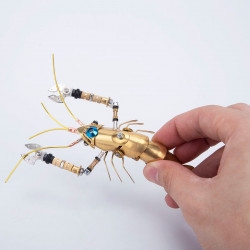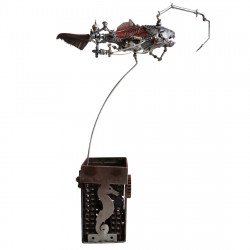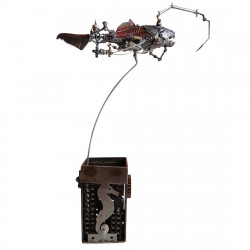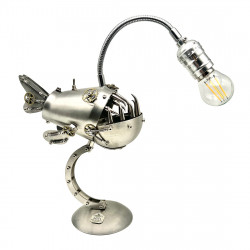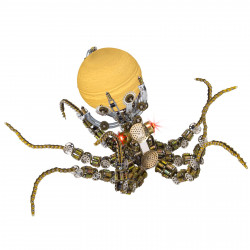Ocean Series
The elongated bodies of anglerfish and the dorsal spine, which extends from the head and has a fleshy lure at its apex, are characteristics of this group of fish. The anglerfish uses its keen teeth to snare its prey, which it attracts with this lure, also called an esca. The fish can control the bioluminescent bulb that tips the spine, allowing it to flash on and off. When the anglerfish gets close enough to its unsuspecting target, it clamps its jaws shut to capture it. Smaller fish are drawn to the light. A few popular video games, anime shows, and motion pictures also feature anglerfish, usually shown as unsettling creatures because of their distinctive appearance.
Found in deep oceanic waters, anglerfish are especially well-suited to withstand the harsh circumstances of the deep sea, where they can endure crushing pressures and total darkness. They are particularly well-known for their incredibly peculiar mating habits, in which the males of many species, who are smaller than the females, physically fuse to become nothing more than organs that produce sperm.
The following are some "funny" facts about anglerfish:
1. They lure prey with their "fishing rod," or illicium, a modified dorsal spine that protrudes from their forehead. Because of its bioluminescent bulbous tip, the spine can resemble a little lamp that is affixed to its head.
2. Anglerfish have a distinct mating habit frequently referred to as "romantic" metaphorically but not in the traditional sense. In certain species of anglerfish, the way the males cling to the females is rather comical and reminiscent of a forever-married pair. In certain species, the males possess a modified dorsal fin, which they use to bite onto the skin of the female. These males are also significantly smaller than the females. For the remainder of their lives, they will remain affixed to the female, feeding on her blood vessels and fertilizing her eggs when she lays them. We refer to this type of reproduction as parasitic reproduction.
3. Male anglerfish in several species are physically fused to females, becoming nothing more than organs that produce sperm. The males are smaller than the females. In scientific terminology, this is called "sexual parasitism" or "induced monofacty." Anglerfish are the only fish with this behavior, which is assumed to be an adaptation to their deep-sea habitat's low population density and lack of available mates. Since this peculiar mating activity is a rare, intimate, and severe type of adaptation—a means by which the fish have found to ensure the continuance of the species in their harsh environment—it is frequently referred to as "romantic" in a figurative sense.
4. It's also important to keep in mind that many individuals may find this conduct repulsive and ugly, and they may not even consider it romantic. Everybody views the world differently and interprets it in different ways.
5. Some anglerfish have a unique feature that gives them the appearance of being perpetually shocked or depressed because of their big eyes and projecting illicium.
6. Anglerfish are also renowned for having voracious appetites; they have been known to swallow prey larger than themselves. Because they are animals that manage to survive in the deep ocean and are an example of adaptation in a harsh environment, some individuals might find them fascinating. They can be seen as a sign of the enigmatic and unknown in a way that arouses interest and awe.
7. The majority of the known species of anglerfish are found in the North Atlantic, North Pacific, and Antarctic Oceans; however, because of their habitat, it might be challenging to determine how many of them are found in a given location or how many species are still undiscovered. Certain species, such as the anglerfish belonging to the Ceratioidae family, exist globally, while certain species are restricted to particular areas or environments.
Norway, China, Japan, and Russia are the nations that fish for anglerfish in large amounts for commercial purposes. These are the countries with the highest commercial anglerfish catches. However, depending on several variables like population density, fishing laws, and market conditions, the quantity of anglerfish captured by these nations may differ yearly.
It is crucial to ensure that fishing is done sustainably because the IUCN considers numerous species at risk of extinction and anglerfish stocks to be sensitive to overfishing.
People catch anglerfish for several purposes, but primarily for food and trade.
Anglerfish meat is prized for its flavor and texture in certain cultures, where it is regarded as a delicacy. They also have edible liver and roe, which are prized in some regions. They can be grilled, pickled, or stewed and are occasionally used in soups and stews.
Anglerfish are harvested for their commercial worth in addition to being utilized as food. Vitamins A and D can be found in large quantities in anglerfish liver oil, used in the nutritional supplement and pharmaceutical industries. Anglerfish are also utilized as bait for other commercial fish species, such as tuna, in some areas.
A few species of anglerfish are also employed in scientific studies to learn more about the behavior, adaption, and preservation of deep-sea fauna.
It's important to note that some experts view the anglerfish fishing industry as unsustainable because of the biological reasons behind the fish and the difficulties and high costs associated with fishing at such deep water levels. Fishing can have a significant effect on the population of anglerfish because they are known to have a long lifetime and a low reproduction rate. Additionally, because it is difficult to examine their habitat, experts know very little about the overall population and the extent to which fishing may be done responsibly. Therefore, it's critical to ensure that fishing for these species is done sustainably to protect the population.
8. Why anglerfish appeals to artists
Due to their strange and characteristic appearance, anglerfish are:
- A popular topic in art.
- Appearing in both new and classic media, such as video games and animation.
- Conventional forms like paintings and sculptures.
Their savage appearance is further enhanced by their bioluminescent lures and pointed fangs. Many artists find inspiration in the deep marine habitat, which is enigmatic and little understood by humans. Among its distinctive species is the anglerfish. For many artists, it can be a thrilling challenge to create something imaginative and otherworldly amid the atmosphere of the deep sea.
Additionally, their peculiar and unusual mating behavior—in which the males fuse to the females—offers a philosophically rich subject for artistic representation. Examples of how this subject can be interpreted include the ideas of fusion, reliance, and symbiosis.
To put it another way, the deep sea's enigmatic and mystical environment and the Anglerfish's peculiar look and biology make it an intriguing topic for artistic expression that offers artists a lot of inspiration to produce fascinating and original works.
Some people may find the strange and distinctive appearance of anglerfish off-putting. They can seem frightening or scary to some because of their pointed fangs, protruding dorsal spines, and elongated bodies. Additionally, their bioluminescent lure—which they employ to entice prey—combined with their deep-sea home can give them a surreal, unsettling appearance.


